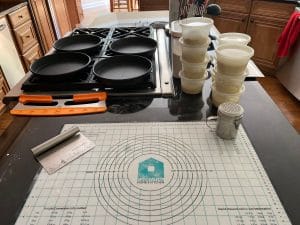Solved: the mystery of measuring

When it comes to making pizza, or baking in general, it’s always good to have a dependable measuring strategy. If you’re like me, measuring can become complicated if you are trying to follow a recipe. One common problem is measurement thing. Some recipes specify ingredient measures in cups, ounces or grams; or all three in one recipe.
The key to good dough is having precise measurements. The gold standard for accuracy is to measure in grams. Easy, right? Not so fast! The problem is converting measurements. Many dough recipes that I have come across mix their weight specifications. One gram of yeast, 11 ounces of water, 3 cups of flour! Frustrating, I say. Add to that, if you want to scale your recipe, OH MY!
A couple of tricks
After a lot of trial and error, I use a couple tricks to give me consistent results. First, stick to grams. Well that’s great but how do you measure the weight of flour? It’s complicated because not all flour weighs the same. When you look at King Arthur’s website (my preferred all-purpose and bread flour), they claim a cup of flour weighs 120 grams. Other sites specify 157 grams. Wow, that’s a big difference. That’s almost a 25% difference! You can imagine how that could throw off a dough recipe!
So what do we do about that? That’s where we get into trick #2. When you look at a recipe, you need to calculate percentages! This will guarantee accurate scaling.
This is how it works. Let’s say you have figured out that 1 cup of your flour is 120 grams as in the King Arthur Bread Flour. The recipe calls for 3 cups (360 grams) of flour.
You are always going to use the flour as your base. Every other ingredient (water, oil (optional), salt, yeast) is measured in terms of a percentage of the flour. According the epic baking steel 72 hour pizza dough, Andris has already put everything into grams. The recipe calls for 1100g of flour and 780g of water. If you divide the water by the four measurement you come up with .71 (rounded), which in bakers terms is 71% hydration (amount of water ratio to your flour). The recipe calls for 38g of fine sea salt which is 3% and yeast (the amount of yeast is VERY small). I like to add oil to some of my dough recipes so I use 3% as my guide. If I were to add oil to this recipe I would add about 30g.
As you can see, scaling becomes pretty easy. To make a smaller batch of this recipe, pick out the amount of flour, let’s say 600g and then apply your percentages to the rest of the recipe (430g of water, 18g of salt, maybe 1.5g of yeast and if using oil add 18g.
There you have it. Now go make pizza!
